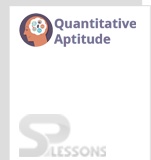 Introduction
Introduction
What is Quantitative Aptitude test?
Quantitative Aptitude is one of the prominent competitive aptitude subjects which evaluates numerical ability and problem solving skills of candidates. This test forms the major part of a number of important entrance and recruitment exams for different fields. The Quantitative Aptitude section primarily has questions related to the Simplification, Numbering Series, and Compound Interest, etc.
A candidate with quantitative aptitude knowledge will be in a better position to analyse and make sense of the given data. Quantitative Aptitude knowledge is an important measure for a prospective business executive's abilities.
The article TS CAB Recruitment Quantitative Aptitude Quiz 5 provides Quantitative Aptitude questions with answers useful to the candidates preparing for Competitive exams, Entrance exams, Interviews etc. The article TS CAB Recruitment Quantitative Aptitude Quiz 5 will assist the students to know the expected questions from Quantitative Aptitude.
 Quiz
Quiz
1. Three candidates contested an election and received 1136, 7636 and 11628 votes respectively. What percentage of the total votes did the winning candidate get?
- A. 57%
B. 60%
C. 65%
D. 90%
- A. Rs. 200
B. Rs. 250
C. Rs. 300
D. None of these
- A. Rs. 15
B. Rs. 15.70
C. Rs. 19.70
D. Rs. 20
- A. Rs. 6876.10
B. Rs. 6876.10
C. Rs. 6654
D. Rs. 7000
E. None of these
- A. 4.37%
B. 5%
C. 6%
D. 8.75%
1. Present ages of Sameer and Anand are in the ratio of 5 : 4 respectively. Three years hence, the ratio of their ages will become 11 : 9 respectively. What is Anand's present age in years?
- A. 24
B. 27
C. 40
D. Cannot be determined
- A. 7
B. 8
C. 9
D. 10
E. 11
- A. 14 years
B. 18 years
C. 20 years
D. 22 years
- A. 16 years
B. 18 years
C. 20 years
D. Cannot be determined
- A. 12 years
B. 14 years
C. 18 years
D. 20 years
1. At present, the ratio between the ages of Arun and Deepak is 4 : 3. After 6 years, Arun's age will be 26 years. What is the age of Deepak at present ?
- A. 12 years
B. 15 years
C. 19 and half
D. 21 years
- A. 16 years
B. 18 years
C. 28 years
D. 24.5 years
- A. 720
B. 900
C. 1200
D. 1800
- A. 12 kg
B. 60 kg
C. 72 kg
D. 96 kg
- A. 4830
B. 5120
C. 6420
D. 8960





